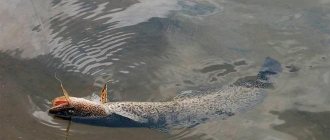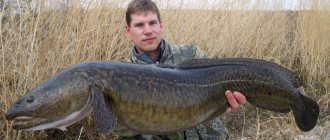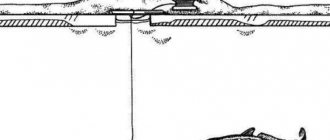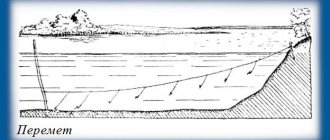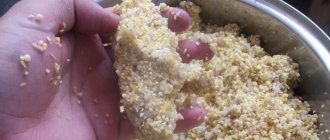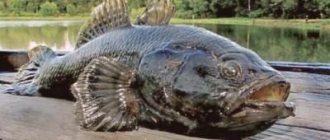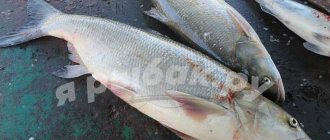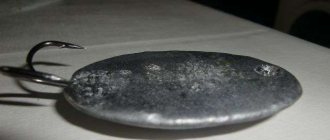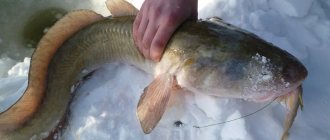Author of the article
Andrey Soprykin
Professional fisherman with 23 years of experience.
Articles written
85
Fishing for burbot in the fall allows you to get a rich catch. When the temperature in the reservoir drops to +11...+12 degrees, it begins to be active, unlike other predators, which, on the contrary, become passive. It is best to start fishing for this fish from the end of September. It is at this time that the temperature on the river drops to the required level, and burbot begins active hunting in preparation for winter.
Rice. 1. Burbot can grow to very large sizes (about 1.5 m).
Fishing location, preferred weather and time
Before you go fishing, you need to understand where to look for a predator. Fish from the cod family prefer areas with a rocky bottom, where they hide behind large cobblestones. Where to look in the fall: it can be found near coastal edges and pools, at the outlet of their holes near the shore, near snags submerged near the ground. That is, burbot lives where it has the opportunity to hide.
This fish goes hunting at night, so it is advisable to go fishing only at dusk and fish until the morning. A bite during the day is possible, but extremely rare. If you go when it is light, there is a risk of being left without prey, when the target is burbot.
Unlike many fish, this predator does not like sunny and warm weather. He prefers bad weather. Good bites are observed on windy and rainy nights. When going fishing in such weather, you need to take care of warm clothes, a waterproof raincoat, warm food and tea in advance.
We recommend watching a very useful video about catching burbot:
Features of catching burbot on a donk in September, October and November
As you already understood from the article, burbot is a fish that loves cold water. Therefore, autumn and early winter is the time to start hunting for him. There is no clear delineation by month for catching burbot, but some of the habits of this fish can be distinguished.
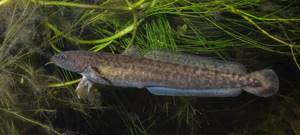
- September. The first month of autumn, during which the water just begins to cool. The burbot “wakes up” and begins to prepare for the pre-spawning feast, so catching burbot on the bottom is not very promising compared to the other autumn months. You can, of course, go after him this month, but you may not achieve any results.
- October. Catching burbot on a donk in October is considered more promising than in September. At night he goes out “hunting” in search of food. It mainly sticks to the bottom, since there is a lot of food for it on it. You can catch burbot in October, but it is better to wait until November.
- November. The peak activity of burbot in the fall occurs in November. In fact, he begins to have a real glutton before spawning. Therefore, if you decide to catch burbot on a donk in the fall, then November is the most suitable month.
On the donk
When deciding how to catch burbot in the fall, it is recommended to give preference to methods from the bottom. Donka fishing shows excellent results; there are two tactics:
- Active (sports). In this case, a small number of gears are used (from 1 to 3). The fisherman does not sit in one place, but constantly moves with the main bottom fishing rod, exploring new areas. You can also use a feeder, but slightly modified for burbot. This will allow you to quickly notice the bite and make a timely hook. However, you need to be prepared for the fact that you will have to spend time to get a good catch.
- Passive (deliverable). In this case, a large number of gears (up to several dozen) are installed on the river. The fisherman does not sit with them, he only walks around periodically, checking the catch. This kind of fishing with a donk involves the use of hooks or girders. To see a bite in a timely manner, you can equip these devices with bells or signal flags.
Expert opinion
Valery Andreevich Sizov
Professional fisherman with 35 years of experience
Please note! Each fisherman decides for himself how to catch a predator. The second method allows you to calmly relax by the fire, and the predator will be caught himself. However, there is nothing exciting or exciting about this. You can use these techniques simultaneously to get a big catch. That is, passive gear is placed along the shore, and the fisherman moves along it with a fishing rod to find the burbot’s resting place.
Catching burbot in the fall with a catch
Autumn fishing for burbot is considered one of the most productive. The fact is that the activity of this fish increases precisely with the onset of autumn, when the water becomes colder every day. You can go after it with either a spinning rod or a feeder, but the most effective tackle is rightfully considered a throwaway. A few of these rigs placed along the shore near the burbot's favorite spots will significantly increase your chances of bringing home the desired catch.
Today we will look at the question: “how to catch burbot in the fall on a donk,” based on “advice from the Internet” and the opinions of experienced fishermen.

Basic requirements for fishing line
Regardless of the gear used, the requirements for the leash and fishing line are identical:
- Possibility of quick replacement. Often the burbot grabs the hook too deeply, and pulling it out can be quite problematic. Therefore, it is recommended to use leashes with a fastener that can be quickly unfastened or prepare several pieces at once so that they can be trimmed if necessary.
- Use of tungsten equipment. Of course, burbot does not have such sharp teeth as pike. Therefore, it will take him time to gnaw through a regular fishing line. However, in a few bites he is able to do this. In order not to change the leash frequently, it is recommended to use tungsten. In addition, when fishing for burbot, pike can also bite.
- Thickness requirements: main line 0.4-0.5 mm, lead sinker and bait 0.3 mm. Such a large cross-section is due to the fact that burbot lives on a rocky bottom. There is a high probability that the equipment will catch on the cobblestones and get stuck between the boulders. Therefore, the stronger the line, the better. You can safely pull and release it without fear of tearing it.
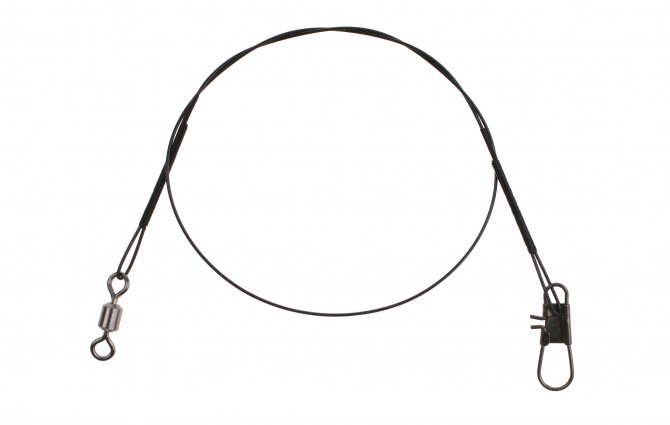
Rice. 2. What is a leash with a clasp?
On a classic bottom fishing rod
Usually, conventional spinning does not bring results, because... Burbot has poor eyesight and may simply not notice the bait. It relies mainly on its sense of smell. Therefore, this tackle needs to be slightly re-equipped to make it a rod for jig fishing.
To do this, take a spinning rod with 10-20 g of dough and a sinker corresponding to this weight. The length of the rod should be about 2.7 m, with a fast action. A spinning reel with a 2500-3000 spool and braided line with a cross-section of 0.4 mm is suitable. You can use a bell on a leash as a bite alarm. It is installed on a stand to the fishing rod and clings to the fishing line in a gentle way, for example, with a weak clothespin.
To the feeder
This is an English fishing rod with a flexible rod tip, which is also a bite alarm. For equipment, monofilament fishing line or film with a cross-section of about 0.3 mm is used. At its end there is a feeder with a load and hooks. This makes it possible to simultaneously catch a predator and feed it so that it does not leave the area. The equipment used is a spinning reel with a 2500-3000 spool. For bait, you can use live bait, a bunch of worms, or larger cut fish.
When feeder fishing, you need to constantly monitor the tip of the rod if it is fixed to the ground. The tackle does not have a sound signal, like a jig. The bite can only be determined visually. If the feeder is in your hands, you can feel that the fish has bitten. After the predator grabs the bait, you need to immediately hook it. Otherwise, the filling will break or swallow the hook too deeply, which can damage the insides.
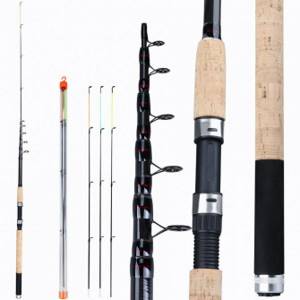
Rice. 3. What is feeder tackle?
Bait for burbot
It is almost impossible to change the burbot trails. The predator changes its usual directions of movement only in the event of human intervention (driving piles, etc.) or a natural change in the bottom topography. But the burbot trail is not a narrow path. It is a strip with a hard bottom, on which small inhabitants of the reservoir and bottom organisms concentrate. Bait for burbot is designed to retain it in the place of fishing.
For complementary feeding, pieces of fish, animal waste and other crushed bait are used: worms, fresh liver, etc. The prepared components are mixed with soil from the reservoir. The viscosity of the bait balls should ensure their disintegration at the bottom. It is better to deliver bait using dump truck feeders.
It is advisable to prepare bait with a reserve. After the bite stops, you need to add another portion of the bait mixture.
Installation of a snack
The zakidushka is the simplest bottom tackle of the passive type. It can easily be made from scrap materials:
- Tie a hook to the fishing line.
- Use an angular stone tied with hemp twine as a sinker.
- Secure the second end of the fishing line to a peg.
- Drive the holder into the ground on the bank.
The advantage of such bottom tackle is that it takes up little space and is light in weight. If you wish, you can take several hooks with you on a fishing trip and place them along the entire shore. In addition, you don’t need to spend a lot of money on such gear. They are made by hand.
Expert opinion
Valery Andreevich Sizov
Professional fisherman with 35 years of experience
Note! You can place the dumpsters in the evening, and come check them only in the morning. This eliminates the need to sit on the shore all night and wait for a bite. If a burbot grabs a hook, it won’t go anywhere, even if it stays on it for several hours. The most important thing is not to leave this bottom tackle unattended for a long time near snags, sunken branches, etc. There is a risk that a predator will become entangled in them.
Rice. 4. Homemade snacks.
How to make a burbot bait with your own hands
Having become familiar with the principle of operation and design of the tackle, the fisherman prepares the material necessary for the manufacture of the product. To do this, prepare a piece of plywood for the reel, monofilament and braided fishing line according to the diameters indicated in the previous chapter, sliding sinkers or lead for their independent melting, as well as hooks.
Important! Among the auxiliary elements for assembling the hook, damper beads would be useful to prevent the occurrence of defects from the impact of loads on the equipment components and fasteners for attaching leashes to the main fishing line.
Alarms can be purchased at a fishing store, or you can make them yourself by adapting the base of used incandescent lamps to the bells, installing freely moving reeds made of a metal rod in them. The production of a set of hooks will be facilitated by the presence of a tool such as a jigsaw or a small hacksaw for wood and a penknife. As you can see, having this small list of necessary materials and tools in stock, such tackle can be assembled right on the shore of a reservoir in just 15–20 minutes, and believe me, a predator can be caught quite effectively with this simple device.
The best baits
It is impossible to say exactly what the predator bites best on. It all depends on its size, usual natural food, weather conditions, etc. Therefore, you will have to select the most suitable bait experimentally.
Zywiec
This bait always works well. Fry or young individuals of various fish can be used as live bait. The bait is placed on the upper lip or behind the back. You don’t have to injure the live bait and use a double hook with a long shank and a leader. They are introduced into the mouth and carefully removed from the gills. Which fish to catch is decided through trial and error.
The gudgeon is most popular among experienced fishermen. This small fish is found in large numbers in all water bodies, so it will not be difficult to catch it for bait. In addition, gudgeon is the natural food of burbot, so it will willingly go for such live bait.
You can use loaches with antennae. It lives in small bodies of water and is not difficult to catch. This live bait is recommended for fishing in small rivers.
In third place in popularity is the ruff. It has a strong odor that burbot can smell from several meters away. This live bait can even be used for fishing without hooks. It must be securely tied to the fishing line by the tail and lowered into the pond. The predator swallows its prey head first. If you pull the line at this moment, the ruff will straighten its spines and get stuck in the throat.
Expert opinion
Valery Andreevich Sizov
Professional fisherman with 35 years of experience
Note! If none of the fish listed above can be caught, then you can use roach, crucian carp, even young animals of large predators. But it should be borne in mind that those species that live on the surface of reservoirs are unusual prey for filling. Therefore, he will be reluctant to go to them.
Fish pieces
If the live bait has died, it makes no sense to plant it in its entirety, because he still won't move. It's better to cut into pieces. This way it will smell stronger, and the predator will smell it from afar. You can also use store-bought freshwater fish. If you have sea food in stock, that will do too.
Expert opinion
Valery Andreevich Sizov
Professional fisherman with 35 years of experience
Note! This bait is only effective for 3-4 hours. Then it will lose its aroma or be eaten by other inhabitants of the reservoir.
Frog
Some fishermen claim that it is the best bait. Others say it is of no use. In fact, it all depends on the place of fishing. If there are frogs in a pond with burbot, then he feeds on them and knows what they are. If the predator has never seen them, then most likely he will refuse such a treat. In any case, when determining what burbot bites in a particular place, you need to try frogs. They are placed behind both lips or behind the back (under the ridge).
It is best to use two-year-old frogs or slightly older yearlings as bait. The most favorable time for catching them is August. Then they can be kept in a cool room (for example, in a cellar) in a container with damp grass. The container must be closed with a lid, otherwise the frogs will run away. The most important thing is not to forget to make holes in it for air to enter. Avid fishermen specifically purchase an aquarium with a pond for amphibious turtles. It is periodically cleaned and the water is changed.
Worms
They need to be dug up in the summer or early autumn, when it is still warm. At this time, they dig passages in the surface of the earth; they are easy to find. With the onset of cold weather, they go into the depths. You can store them in a jar with soil in a cool place, for example, in a refrigerator or cellar. You need to plant large or medium-sized specimens, but in a bunch.
Autumn bait
Bait for burbot can be different. In autumn it is recommended to use a worm. The bait attracts small fish, which lures the predator with its actions. Active movements of the bait attract large fish. Choose large dung worms rather than earthworms. Place them in a bunch of 5-6 pieces, clinging to the middle of the body.
Live bait are small fish - ruffe, minnows, gobies, bleaks, roach and crucian carp. The predator is attracted by the smell, so the bait is attached under the fin located at the top. On some individuals, incisions are made. The chosen live bait must be an inhabitant of the reservoir, since burbot will not go for an unfamiliar fish.
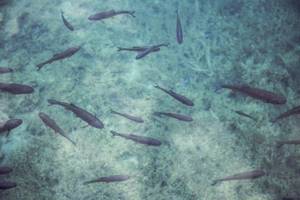
Autumn bait: fishing with live bait
The fillet of fish, which has lain for 12 hours in a closed jar and released its juice, is a good lure for predators, and cut frogs attract large individuals. They cling to the thigh and are first immobilized. Additionally, beef liver, leeches, and shellfish are used. The fish's mouth is small, the size of the bait should not exceed 15 cm.
Lure
There is no need to feed burbot in the fall. For fishing, fairly large and odorous baits are used, so the predator comes to them from afar. However, those who have tried feeding fish note a positive effect. She manages to be detained in one place and even brought to him. Plant components are not suitable as bait. You need to use balls made from minced meat, chopped worms, meat, its by-products, etc.
Summing up, we can conclude that it is best to go for burbot at the end of September, when the water temperature drops below +13 degrees. At this time, he becomes active and willingly takes various baits of animal origin. For fishing, you can use both active and passive tactics. To catch a large number of fish, it is recommended to combine two methods. That is, place the nooks along the shore at a distance of 10-15 m from each other, move in parallel with a fishing rod, exploring the most interesting places.
Fishing technique
Regardless of the type of bait used, the fishing technique follows the same principle. After casting, bites are expected, in the absence of which the tackle is checked every 1.5-2 hours, inspecting the bait for its presence and suitability. The bite itself may not be distinguished by the persistence of the alarm and may manifest itself only with a single flinch of the bell, after 15 minutes after which the tackle is checked, in most cases receiving an already detected but hidden trophy.
A not very active burbot, having made an effective throw, begins its meal right at the site of the attack, which causes a weak bite signal. When the bell is constantly working, you need to immediately rewind the cord, otherwise the predator will go to its secluded place and hopelessly tangle the tackle. When playing, the fish is not given any slack, forcing it to be pulled to the shore. Thick cords and deep-throated hooks rarely allow an individual to bite and leave the angler without luck.

